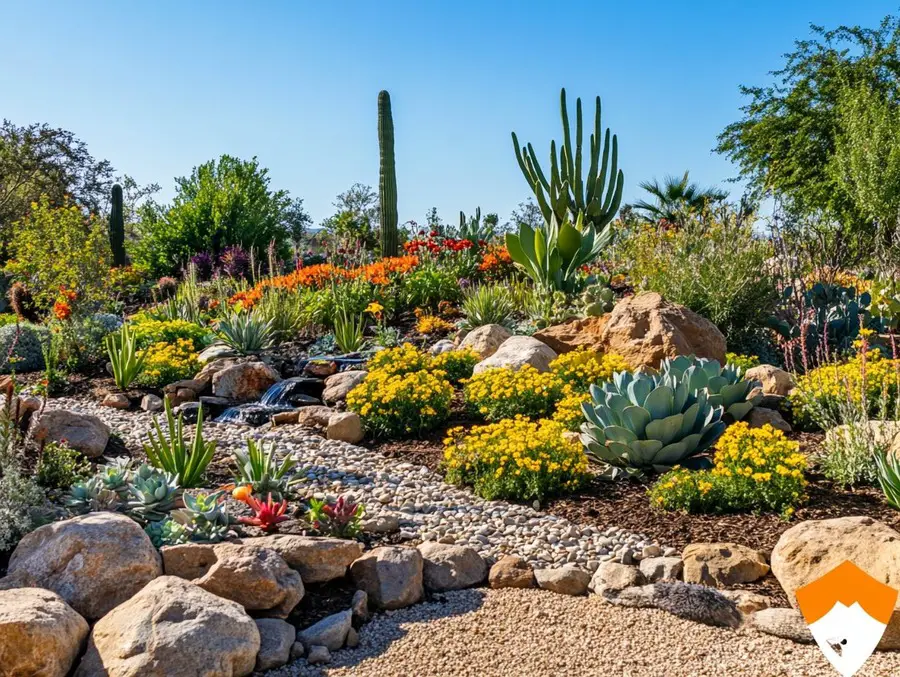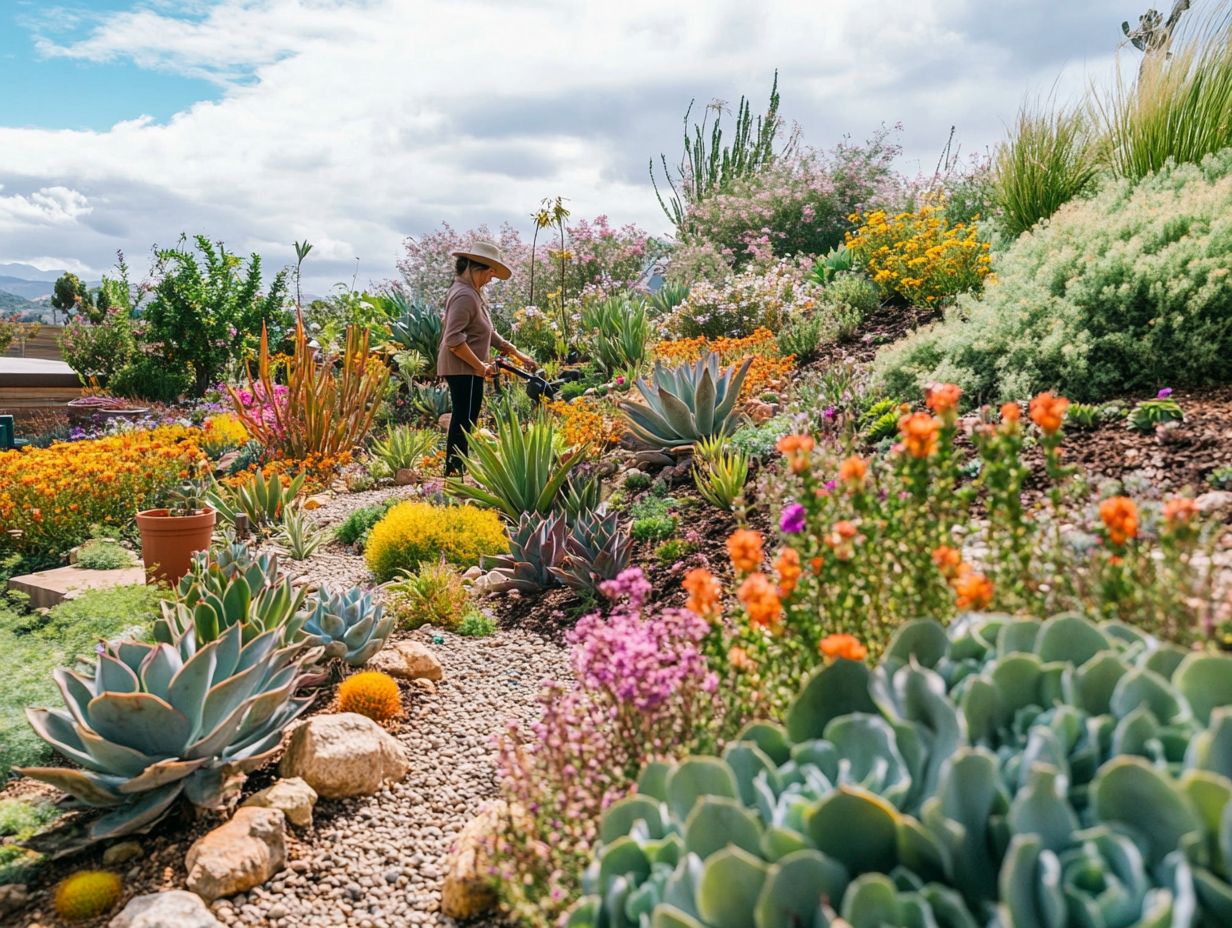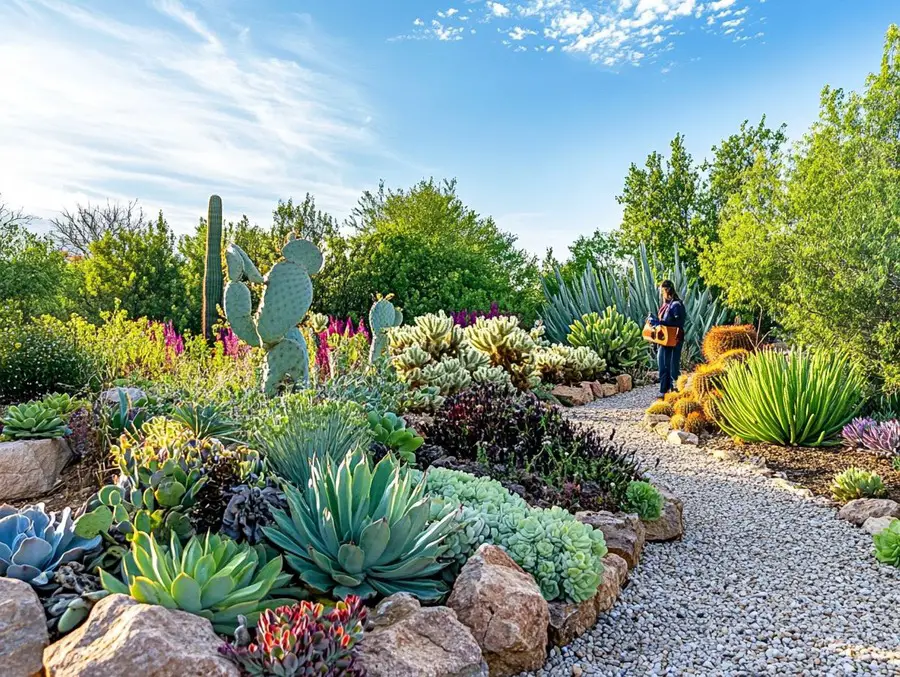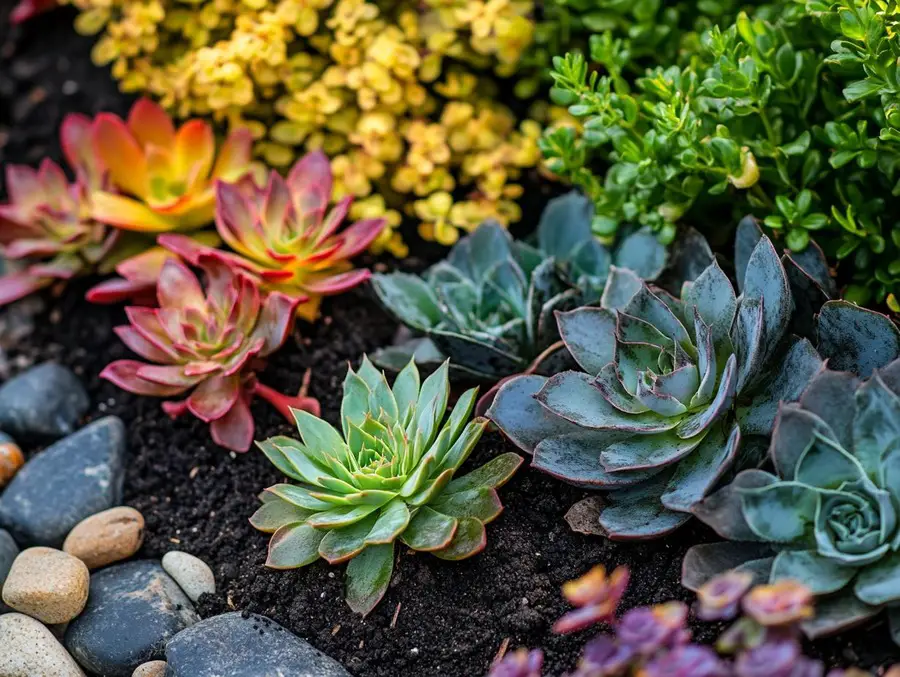We use affiliate links. If you purchase something using one of these links, we may receive compensation or commission.
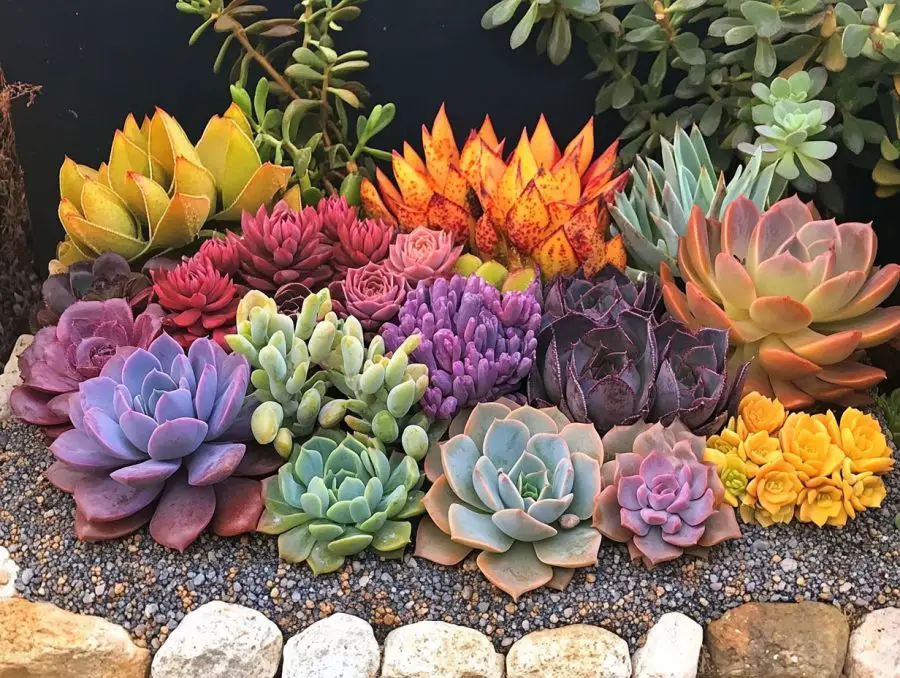
Succulents for Xeriscaping are the perfect solution for a water-wise, low-maintenance landscape that still looks stunning year-round.
Tired of battling high water bills and struggling with thirsty plants?
Succulents thrive in dry conditions, offering vibrant colors and unique textures without the hassle.
With the right plant choices and simple care techniques, you can create a sustainable, drought-resistant garden that flourishes effortlessly!
Succulents for Xeriscaping
Key Takeaways
- Succulents for Xeriscaping are drought-resistant plants ideal for water-wise landscaping.
- They store moisture in their leaves, making them perfect for dry climates.
- Popular choices include Agave, Echeveria, and Sedum.
- With minimal watering needs and easy maintenance, succulents help create sustainable, low-water gardens that thrive in arid conditions while adding vibrant color and texture.
Succulents for Xeriscaping: Thriving Gardens with Less Water
Water conservation is more crucial than ever and xeriscaping offers you a fantastic, sustainable solution for landscaping that flourishes in dry conditions.
This approach is all about succulents, those gorgeous plants that are known for their vibrant colors and their impressive resilience.
You’ll want to start by picking the right varieties and designing a drought-resistant landscape.
With some practical tips, you can easily maintain these low-maintenance plants.
Jump into the world of succulents and turn your outdoor space into an eco-friendly oasis!
What are Succulents for Xeriscaping?
Xeriscaping is a clever way to design your outdoor space with water conservation in mind.
It focuses on using drought-tolerant plants, native flora, and sustainable gardening practices to create beautiful living areas.
By prioritizing xeric plants like succulents, cacti, and other desert plants, you can significantly reduce the need for irrigation and cut down on water usage.
This approach has some great environmental benefits!
It adapts well to different soil types and climate conditions, making it a smart choice for areas that often face drought and water shortages.
Why Use Succulents?
Succulents are a fantastic choice for your garden design, especially if you’re into xeriscaping.
These drought-tolerant plants thrive in low-water environments, making them both stunning and practical.
With their unique ability to store water in their leaves, they can handle arid conditions like champs.
They look great, but they also promote biodiversity and eco-friendly gardening.
With all the shapes, sizes, and colors they come in, succulents can really boost your garden’s aesthetic while requiring minimal maintenance.
That’s a big win for anyone wanting to cut back on water consumption.
Their adaptability means succulents fit right in, whether you put them in garden beds, pots, or vertical gardens.
Pairing them with rocks or wooden accents can create a gorgeous visual display, harmonizing your outdoor space perfectly.
To really make them pop, think about mixing them with plants that have different textures or colors.
Most succulents do well with the right lighting and just a bit of occasional watering, helping them stay vibrant while also supporting sustainable gardening practices by reducing the need for chemical fertilizers and excessive irrigation.
Choosing the Right Succulents for Xeriscaping
Choosing the right succulents for your xeriscape design means getting a handle on the plant selection criteria, like hardiness, soil types, and climate resilience.
Different succulents thrive in different conditions, so it’s crucial to think about things like sunlight exposure, soil amendments, and watering techniques when you’re planning your xeric garden.
By focusing on native and drought-resistant varieties, you can create a lush and sustainable outdoor space that needs little maintenance and adds seasonal interest all year round.
Factors to Consider
When you’re picking succulents for your xeriscape garden, you’ve got a few things to consider, like soil types and irrigation options, which can really make a difference in how healthy and happy your plants are.
It’s super important to understand your local climate and choose varieties that can handle the heat and low moisture levels if you want to create a sustainable landscape.
Thinking about maintenance needs and the latest landscaping trends will help you put together a diverse and visually appealing garden that thrives with minimal effort.
Don’t overlook soil quality. It’s key to building a healthy succulent ecosystem.
You’ll want a well-draining mix with some perlite or sand so that excess water doesn’t stick around and cause root rot.
Sunlight exposure is another biggie. While most succulents love bright, indirect light, they can adapt to different conditions based on their species.
If you’re looking to maximize growth and cut down on water use, consider exploring irrigation alternatives like drip systems or rainwater harvesting.
These methods save water and create a thriving environment for your resilient plants.
Popular Succulent Varieties for Xeriscaping
Some popular succulent varieties that are perfect for xeriscaping include native plants like Agave, Echeveria, Sedum, and various cacti.
These plants are known for their drought-tolerant characteristics and vibrant looks.
They bring unique foliage textures and color contrasts to your garden and also boost the overall biodiversity of your landscape.
By adding Mediterranean plants and xeric shrubs, you can create a stunning garden that highlights the beauty of low-water landscaping while staying resilient against harsh weather.
Take Agave, for example. Its striking rosette shapes and sharp architectural lines make it a fantastic choice for minimalist designs.
Then there’s Echeveria, which boasts rosettes of pastel hues that can really complement bolder colors in a mixed plant arrangement.
And don’t forget about cacti—varieties like the iconic saguaro or the smaller, spiny opuntia can add a sculptural element that serves as a focal point in your curated garden.
When you combine these succulent species, you’ll create a visually dynamic landscape that attracts beneficial pollinators while minimizing water usage.
Grouping your plants in clusters based on their needs and textures will enhance both the aesthetic and ecological harmony of your xeriscape.
Designing a Xeriscape with Succulents
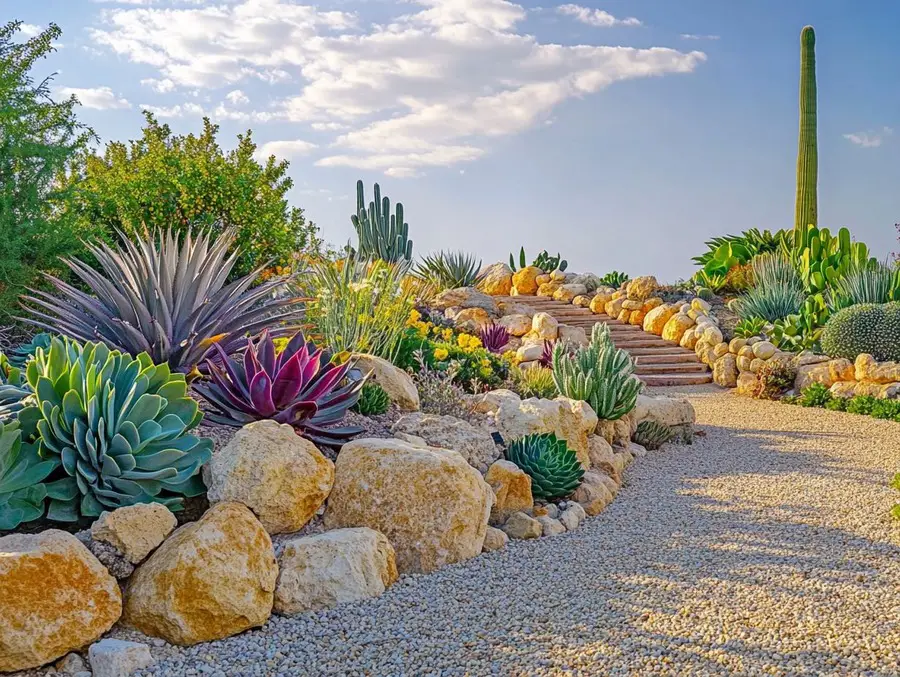
Designing a xeriscape filled with succulents is a great way for you to create an eco-friendly garden that boosts water efficiency and spruces up your outdoor spaces.
By following xeriscape principles, you can pick the right plant combinations that thrive in dry conditions and keep your landscape looking interesting throughout the seasons.
When you strategically arrange succulents alongside other native and drought-tolerant plants, you’ll have a low-maintenance garden that showcases the beauty of sustainable gardening practices.
Creating a Drought-Resistant Landscape
Creating a drought-resistant landscape means you’ll want to embrace xeriscape principles that help you minimize water usage while keeping your garden looking great and healthy.
By using techniques like strategic soil amendments and adding mulch, you can reduce soil erosion and boost moisture retention, which is a win for both your garden and the environment.
Choosing the right plants, especially succulents and other drought-tolerant varieties, will make your landscape more resilient in dry conditions and help you save water.
Don’t underestimate the power of good soil! Using well-draining, organic-rich materials will let those succulent roots thrive without the risk of rot.
Think about mixing in some compost or well-rotted manure to enrich your soil while still maintaining its structure.
In terms of watering, deep watering methods are your friend, and spacing your plants properly ensures that water gets to their roots without going to waste.
Keep an eye out for pests and diseases; a little regular check-in can go a long way in keeping your hardy plants healthy.
With a focus on balancing beauty and sustainability, your thoughtfully planned drought-resistant garden can be a peaceful retreat for you and a thriving ecosystem all at once.
Incorporating Succulents into Your Design
Incorporating succulents into your landscape design can really add some unique textures and colors that elevate the overall look of your garden while also being water-efficient.
By exploring different plant combinations and zoning techniques, you can create outdoor spaces that serve various purposes and vibes, whether you’re aiming for a quiet retreat or a vibrant sensory garden.
Keeping up with landscaping trends can spark new ideas for showcasing succulents alongside ornamental plants and other drought-tolerant species.
To create a harmonious blend, it’s crucial to think about how to arrange the different types of succulents in your space.
For example, grouping plants with similar light and water needs will help them thrive in their designated zones.
Vertical gardening is another fun approach that lets you layer your plants, boosting visual interest by integrating climbing succulents with taller greenery in the background.
Mixing up pot heights and textures can also bring some aesthetic variety without losing that cohesive look, making your outdoor space modern and inviting while aligning with the latest sustainable gardening trends.
Maintaining Succulents in a Xeriscape
Maintaining succulents in a xeriscape setting is a breeze. These resilient plants are all about that drought-tolerant life, so knowing how to care for them is key.
You’ll want to get familiar with watering techniques, seasonal planting schedules, and pest management strategies to keep your garden healthy and thriving.
With a little bit of planning and some organic gardening practices, you can create a stunning xeriscape that stays vibrant and beautiful all year round, all while doing your part for sustainable landscaping.
Watering and Fertilizing Tips
Implementing effective watering and fertilizing tips is key to keeping your succulents healthy in a xeriscape environment.
Since succulents are drought-resistant, you won’t need to water them as often as traditional garden plants, but it’s vital to establish a consistent watering routine.
This way, you’ll ensure that the roots get enough moisture without drowning in overly saturated soil.
Using organic gardening practices for fertilization can boost plant health and add some seasonal flair with vibrant growth and flowers.
To care for these tough little plants, it’s a good idea to adopt a deep watering approach.
This means giving them a good soak every two to three weeks during their active growing season to make sure the moisture reaches the roots.
You might also try bottom watering, where you place the pots in water so they can absorb it from the bottom up.
In terms of fertilizing, go for organic options like compost tea or diluted fish emulsion.
These provide essential nutrients without the worry of chemical buildup.
This natural method enriches the soil and supports beneficial microorganisms, helping your succulents thrive and flaunt their unique colors and textures all year round.
Dealing with Pests and Diseases
Dealing with pests and diseases in your succulent garden calls for some proactive pest management strategies that vibe with organic gardening principles.
While succulents are pretty tough, they can still fall prey to certain pests and diseases that threaten the health of your garden.
That’s why it’s crucial to understand common issues and put preventative measures in place.
By choosing pest-resistant plants and keeping an eye on your garden with regular monitoring and care, you can boost the resilience of your xeriscape and help your garden stay vibrant and flourishing.
Watch out for common pests like mealybugs, aphids, and spider mites, which can sap the life out of your unique plants.
You can tackle these invaders by introducing beneficial insects like ladybugs or using natural insecticidal soaps to keep them in check.
Don’t forget about diseases like rot that can result from overwatering.
Make it a habit to let the soil dry out between watering sessions to reduce these risks.
Picking specific succulent varieties that are naturally resistant to pests can also improve the overall health of your garden.
By focusing on these organic practices, you can create a thriving environment where your succulents can flourish without being bothered by pests and diseases.
Succulent Propagation for Xeriscaping
 Succulent propagation is a fantastic way for you to grow your xeriscape garden while embracing sustainable gardening practices that boost plant diversity.
Succulent propagation is a fantastic way for you to grow your xeriscape garden while embracing sustainable gardening practices that boost plant diversity.
By using effective propagation techniques like leaf cuttings or offsets, you can create new plants from the ones you already have, which is especially rewarding in a xeriscape environment.
This adds some visual flair to your garden with varied ground cover, but it also helps you save money on buying new plants.
Methods for Propagating Succulents
There are several effective methods for propagating succulents that you can try, like leaf propagation, stem cuttings, and offsets.
Each of these methods requires specific plant care techniques to help ensure successful growth.
Understanding the best soil types and watering techniques for each method is key to maximizing your propagation success.
When you’re propagating succulents using leaf cuttings, be sure to select healthy leaves and let them callous over before planting.
This little step is crucial because it prevents rot and promotes rooting.
For stem cuttings, cutting the stem at an angle can boost water absorption, and using a gritty soil mix will help keep away that pesky excess moisture.
If you’re working with offsets, gently remove the baby plant, making sure to keep a portion of the roots intact, and plant it in well-draining soil.
For all these methods, the ideal conditions involve bright, indirect light and minimal watering until the roots establish.
Following these care tactics will significantly increase your chances of nurturing thriving succulents.
Using Propagation to Expand Your Xeriscape
Using propagation techniques to expand your xeriscape garden is a smart way to diversify your plant collections while keeping your gardening sustainable.
By growing new succulents from your existing plants, you can add various species and combinations that boost both biodiversity and visual appeal in your landscape.
This method cuts down on the need to buy new plants, helping to create a more interconnected ecosystem right in your garden.
By incorporating different plant varieties through propagation, you can build a resilient garden that’s ready to adapt to whatever environmental changes come your way.
When you’re planning where to place your new plants, think about their mature size and growth habits.
This little bit of foresight will help you avoid overcrowding and ensure that sunlight and nutrients are evenly shared.
Mixing up textures and colors doesn’t just make your design pop.
It also attracts a range of beneficial pollinators, making your garden ecosystem more vibrant.
So, embrace the natural variations that come from propagation—they add a rich tapestry of life that makes your xeriscape both beautiful and sustainable.
Frequently Asked Questions
What are succulents and how can they be used for xeriscaping?
Succulents are plants that have thick, fleshy leaves and stems that store water.
They are perfect for xeriscaping as they are drought-tolerant and require minimal watering.
What are the benefits of using succulents for xeriscaping?
Succulents are low-maintenance plants that require little water and are able to withstand hot and dry climates.
They also come in a variety of shapes, colors, and sizes, making them a great addition to any xeriscaped garden.
Which succulents are best for xeriscaping?
There are many types of succulents that are suitable for xeriscaping, such as agave, aloe, sedum, and yucca.
It’s important to choose succulents that are native to your region and can thrive in your climate.
How do I care for succulents in a xeriscaped garden?
Succulents are low-maintenance plants, but they still require some basic care.
Make sure they have well-draining soil and are placed in a sunny spot.
Water them deeply but infrequently, allowing the soil to dry out between waterings.
Can I use succulents for xeriscaping in any type of climate?
Succulents are typically found in dry and arid regions, but there are also varieties that can thrive in more humid climates.
It’s important to research which succulents are best suited for your specific climate before using them in your xeriscaped garden.
Do I need to replace my succulents in a xeriscaped garden every year?
No, succulents are long-lasting plants and do not need to be replaced every year.
As long as they are properly cared for, they can thrive for many years in a xeriscaped garden.
Best Plants for Xeriscape Gardens: Hardy & Beautiful
Xeriscape Garden Styles: Easy Low-Maintenance Options
Xeriscape Gardening Techniques: Easy Low-Water Tips
Xeriscape Garden Design & Layout: Easy Water-Wise Beauty
What is xeriscaping? A beginner’s guide to drought-tolerant landscaping – Colorado State University
Related Content
Visit my Amazon Influencer Page for videos and gardening products Grow Your Own Garden


